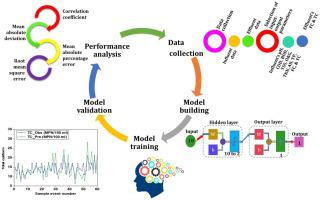Journal of Water Process Engineering ( IF 7 ) Pub Date : 2020-07-02 , DOI: 10.1016/j.jwpe.2020.101477 Narendra Khatri , Kamal Kishore Khatri , Abhishek Sharma

|
Artificial neural network (ANN) models have been designed to predict faecal coliform and total coliform removal for an intermittent cycle extended aeration-sequential batch reactor (ICEAS-SBR). Wastewater influent pH, biochemical oxygen demand (BOD), chemical oxygen demand (COD), total suspended solids (TSS), oil & grease (O&G), total kjeldahl nitrogen (TKN), ammonical nitrogen (AN), total phosphorus (TP), faecal coliform, and total coliform were used to develop the network. The data used to train and test the network were obtained from the Jamnagar municipal corporation-waste water treatment plant (JMC-WWTP). Feedforward backpropagation algorithm with learngdm learning function was used to develop ANN models. The number of neurons in hidden layer were varied between 2–10 to find the most reliable network. The optimum ANN models were selected for faecal coliform and total coliform on trial-and-error method. The performance of designed models was tested by computing correlation coefficient, mean absolute deviation (MAD), root mean square error (RMSE), and mean absolute percentage error (MAPE). The network with 6 hidden neurons was optimum for faecal coliform, and 8 hidden neurons was optimum for total coliform. The produced simulation results were within 5 % of MAPE for both faecal and total coliform. The ANN models allow faecal coliform and total coliform levels in the treated wastewater effluent to be regulated that reduces the public and in particular the oyster consumer’s health risks.
中文翻译:

间歇循环扩展曝气系统-顺序分批反应器废水处理厂中粪便大肠菌群去除的人工神经网络建模
设计了人工神经网络(ANN)模型,以预测间歇循环扩展曝气顺序分批反应器(ICEAS-SBR)的粪便大肠菌群和大肠菌群总数。废水进水pH,生化需氧量(BOD),化学需氧量(COD),总悬浮固体(TSS),油脂(O&G),凯氏氮(TKN),氨氮(AN),总磷(TP) ,粪便大肠菌群和总大肠菌群用于开发网络。用于训练和测试网络的数据是从Jamnagar市政公司废水处理厂(JMC-WWTP)获得的。使用具有learngdm学习功能的前馈反向传播算法来开发ANN模型。隐藏层中神经元的数量在2-10之间变化,以找到最可靠的网络。通过试错法为粪便大肠菌群和总大肠菌群选择了最佳的人工神经网络模型。通过计算相关系数,平均绝对偏差(MAD),均方根误差(RMSE)和平均绝对百分比误差(MAPE)来测试设计模型的性能。具有6个隐藏神经元的网络最适合粪大肠菌群,而8个隐藏神经元最适合总大肠菌群。粪便和大肠菌群的模拟结果均在MAPE的5%以内。ANN模型允许对处理后的废水中的粪大肠菌群和总大肠菌群水平进行调节,从而减少了公众尤其是牡蛎消费者的健康风险。平均绝对偏差(MAD),均方根误差(RMSE)和平均绝对百分比误差(MAPE)。具有6个隐藏神经元的网络最适合粪大肠菌群,而8个隐藏神经元最适合总大肠菌群。粪便和大肠菌群的模拟结果均在MAPE的5%以内。ANN模型允许对处理后的废水中的粪大肠菌群和总大肠菌群水平进行调节,从而降低了公众尤其是牡蛎消费者的健康风险。平均绝对偏差(MAD),均方根误差(RMSE)和平均绝对百分比误差(MAPE)。具有6个隐藏神经元的网络最适合粪大肠菌群,而8个隐藏神经元最适合总大肠菌群。粪便和大肠菌群的模拟结果均在MAPE的5%以内。ANN模型允许对处理后的废水中的粪大肠菌群和总大肠菌群水平进行调节,从而减少了公众,尤其是牡蛎消费者的健康风险。


























 京公网安备 11010802027423号
京公网安备 11010802027423号